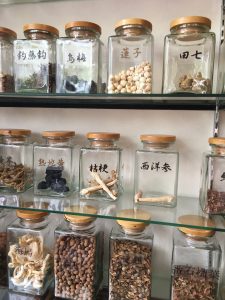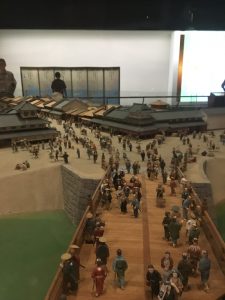Kanpo(漢方): Before meeting Dr. Qiu, I gave a draft of my kanpo-related questions to Aridome sensei (質問は翻訳してありがとうございます!) which he ten sent forward. Dr. Qiu answered all of the listed questions with clarity, but before she did that, she offered us a small a glimpse of her life story and how she ended up as a kanpo doctor. As a child born during late maternal age, she required medical attention, a responsibility which her father as a pediatrician and later a kanji doctor. Through tangible experience, Dr. Qiu decided to follow into her father’s footstep and become a Kanpo practitioner.
Many of the ideas and processes discussed during the lecture resonated with the our readings. Such things were the differences of approach in biomedicine (Bullet Point approach) and Kanpo (Individualistic-Environmental Approach), and the importance of the doctor’s sensitivity to patient’s body language, smell, visual and touch. The new things I learned were:
- Kanpo is an OBSERVATIONAL Science
- Kanpo places more importance and the individual and surroundings than “genetics.” In biomedicine forms it is really important to know the race and ethnicity of an individual as some of us are prone to certain diseases such illness. However, although Kanpo does take into consideration these factors-its main regard is the individual’s body constitution and response to the environment.
- Kanpo’s main goal of restoring balance in the body is achieved through enforcing the body’s immune system or boosting one’s chi or ki. In cases of unknown cause or a new disease, such as radiation exposure, Kanpo’s approach is the above: BOOST THE CHI.
- Dermatologist, Cancer-Treatment Facilities, and women who wish to conceive are embracing Kanpo.
- The difference in kanpo between Japan and China: in Japan, Kanpo and biomedicine are seen as complimentary to one another, while China it is regarded as its own way of medicine (separate from bio medicine) and is practiced independently from biomedicine.

Edo-Tokyo Museum: Definitely, as Selinger Sensei mentioned, no expenses were spared…The museum’s permanent exhibit was extremely detailed. Each model and figurine were carved/molded in such a careful manner…

This past academic year, besides Japanese language classes, my Asian studies courses consisted of Christmas Sensei’s history class: Modernity and Identity, which covers the Meiji restoration till present, and Culture and Conquest, which’s focus is Japan’s pre-modern history. In the Edo-Section, there were palanquins in which the daimyo used to ride in and a model of what a daimyo residence in Edo would have looked like… One of the last things we discussed in class this past semester was Sankin Kotai, which in the ended up draining the financial resources each domain-as each daimyo felt the need to demonstrate its power and influence through wealth and fashion. Seeing the the models finally made me understand how much of a toll this procession must have been… (I should have really taken a picture, すみません). Also, last semester we read a Junichiro’s novel, Naomi. The novel explores life Japanese life in the early 20th century. Culture Homes (houses that were made in half Japanese and half western style) were very popular. The Museum had a life-size model of such a home. I have to say- at had imagined it a little different, a little more eccentric maybe. But seeing it, I understood why Naomi picked out a culture house to live in…
I really like Ukiyo-e prints (a style of woodblock print popular around the Meiji Period). We had discussed the process of woodblock print with Selinger Sensei during class once and I was simply stunned by the intricacy of the process…

